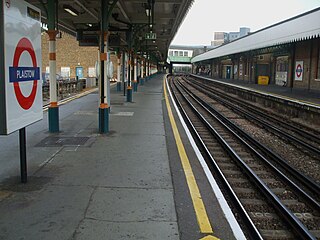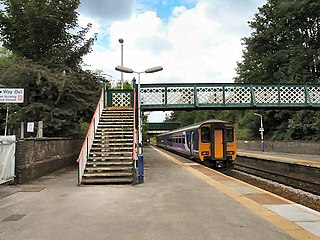Related Research Articles

Rugby railway station serves the market town of Rugby in Warwickshire, England. The current station dates from 1885; two previous stations dating from 1838 and 1840 respectively, existed at locations to the west of the current one. It has been Rugby's only station, since the closure of the former Rugby Central station in 1969, on the now-abandoned Great Central Main Line route through the town. Between 1950 and 1970, the station was known as Rugby Midland before reverting to its original title. The station underwent an extensive remodelling between 2006 and 2008; new platforms were added and a new ticket office and entrance building were constructed. The original Victorian part of the station was retained in the upgrade.

The London, Tilbury and Southend line, also known as Essex Thameside, is a commuter railway line on the British railway system. It connects Fenchurch Street station, in central London, with destinations in east London and Essex, including Barking, Upminster, Basildon, Grays, Tilbury, Southend and Shoeburyness.

Plaistow is a London Underground station on Plaistow Road in the London Borough of Newham in Greater London. It is between West Ham and Upton Park stations on the District and Hammersmith & City lines, and in Travelcard Zone 3.

The Dearne Valley line is the name given to a railway line in the north of England running from York to Sheffield via Pontefract Baghill and Moorthorpe. The route was built over several years and consists of lines built by several railway companies.

Chesterfield railway station serves the market town of Chesterfield in Derbyshire, England. It lies on the Midland Main Line. Four tracks pass through the station which has three platforms. It is currently operated by East Midlands Railway.

Gloucester railway station is a railway station serving the city of Gloucester in England. The station was originally built as the terminus of the Birmingham and Gloucester Railway in 1840, but the arrival of the Bristol and Gloucester Railway and Cheltenham and Great Western Union Railway in 1844, and then conversion to a through station for the South Wales Railway in 1851 resulted in a very complex layout. Subsequent closures and rationalisation have left Gloucester with a station that is located off the main Bristol-Birmingham line, meaning Great Western Railway services must reverse, while CrossCountry and Transport for Wales services continue to Newport. The station is 114 miles 4 chains (183.5 km) from the zero point at Paddington, measured via Stroud.

Peterborough railway station serves the cathedral city of Peterborough, Cambridgeshire, England. It is 76 miles 29 chains (122.9 km) down the East Coast Main Line from London King's Cross. The station is a major interchange serving both the north–south ECML, as well as long-distance and local east–west services. The station is managed by London North Eastern Railway. Ticket gates came into use at the station in 2012.

Mexborough railway station serves the former mining town of Mexborough, South Yorkshire, England. It is a station on the Sheffield to Doncaster Line 7 miles (11 km) south west of Doncaster.

Woodhouse railway station serves Woodhouse and Woodhouse Mill in Sheffield, South Yorkshire, England. The station is 5.25 miles (8 km) east of Sheffield station on the Sheffield to Lincoln Line.

Reddish North railway station is one of two stations serving the suburb of Reddish in Stockport, England; the other is Reddish South.

Kilnhurst is a village in South Yorkshire, England, on the banks of the River Don and the Sheffield and South Yorkshire Navigation. It grew up around the coal mining, ceramics, glass, brick-making and locomotive industries; none of these industries remain in the village.

Kilnhurst Central was a railway station in Kilnhurst, South Yorkshire, England, one of two railway stations serving the village, the other being Kilnhurst West, situated on the North Midland Railway line. Kilnhurst Central was on the former Great Central Railway's (GCR) Sheffield Victoria - Doncaster line, between Parkgate and Aldwarke and Swinton Central.
John Brown's railway was a line constructed in the Rotherham area of South Yorkshire, England, in order to link Silverwood Colliery to staithes situated alongside the River Don. The line, along with the collieries, became the sole property of John Brown & Company of Sheffield, in 1910, giving the line its local name.
Kilnhurst Colliery, formerly known as either Thrybergh or Thrybergh Hall Colliery, was situated on the southern side of the village of Kilnhurst, near Rotherham, South Yorkshire, England.

Barnoldswick railway station was the only railway station on the Midland Railway's 1-mile-64-chain (2.9 km) long Barnoldswick Branch in the West Riding of Yorkshire in England. It served the market town of Barnoldswick, which was in West Riding of Yorkshire at the time. The line left the Leeds and Bradford Extension Railway at Barnoldswick Junction 55 chains from Earby railway station. The line through the junction was on a 20-chain radius after which it converged to a single track and ran in a straight but undulating line to Barnoldswick. The passenger train that ran back and forth between Barnoldswick and Earby was known locally as the 'Barlick Spud' or 'Spudroaster'. The real reason for the name is lost in time, but the two versions that were commonly recited are that the original branch locomotive was so small it looked like a portable potato roaster used by a local vendor or that the journey time was the same as that taken to roast a potato in the locomotive's firebox.
The Dalton Main Collieries Limited became a public company which appeared on the London Stock Exchange in December 1899. The company was set up by John Brown and Company with the aim of purchasing Roundwood Colliery at Parkgate and to purchase land between Thrybergh and Ravenfield, known as Silverwood, and sink a new deep colliery there. By the time production was in full swing at Silverwood in 1909 John Brown were sole proprietors of the Dalton Main Company.

Thrybergh is a village and civil parish in the Metropolitan Borough of Rotherham in South Yorkshire, England, 3 miles (4.8 km) from Rotherham. It had a population of 4,327 in 2001, reducing to 4,058 at the 2011 Census.
The Mangotsfield and Bath branch line was a railway line opened by the Midland Railway Company in 1869 to connect Bath to its network at Mangotsfield, on its line between Bristol and Birmingham. It was usually referred to as "the Bath branch" of the Midland Railway.

Roundwood Colliery was a coal mine situated in the Don Valley, about 2 miles north of Rotherham, South Yorkshire, England on the borders of Rotherham and Rawmarsh.
Thrybergh Junction was a junction on the South Yorkshire Railway, Mexborough to Rotherham line situated about 1 mile south of Kilnhurst Central. The junction was originally controlled by a Manchester, Sheffield and Lincolnshire Railway signal box of the earliest design, almost square with a hipped roof built on stilts. The junction was originally known as Thrybergh Hall Junction and served the line to Kilnhurst Colliery, brickworks and another colliery interest at Warren Vale.